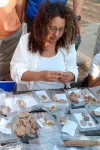Researchers reveal ancient dietary habits and early human use of plant foods
Groundbreaking study led by Bar-Ilan University uncovers the central role of starch-rich plants in the diet of ancient hunter-gatherers
2025-01-06
(Press-News.org)
A new archaeological study, conducted along the Jordan River banks south of northern Israel’s Hula Valley, offers a fresh perspective on the dietary habits of early humans, challenging conventional wisdom about prehistoric diets. The research reveals that ancient hunter-gatherers relied heavily on plant foods, particularly starchy plants, as a major energy source. The findings suggest that, contrary to popular belief, the diet of early hominids was not solely focused on animal protein, but rather, featured a diverse range of plant-based foods, including acorns, cereals, legumes, and aquatic plants.
This multidisciplinary study, published today in the Proceedings of the National Academy of Sciences (PNAS), focuses on the discovery of starch grains approximately 780,000 years old, uncovered from basalt tools at an ancient settlement site near Gesher Benot Ya’akov. The site, located on the shores of the ancient Hula Lake, has provided a wealth of evidence, including over 20 layers of settlement, fossilized animal remains, and plant remnants such as seeds and fruits.
The study was conducted as part of Dr. Hadar Ahituv's doctoral thesis at Bar-Ilan University’s Martin (Szusz) Department of Land of Israel Studies and Archaeology. He is now at the Laboratory for Ancient Food Processing Technologies (LAFPT), at Haifa University’s Zinman Institute of Archaeology. This collaborative research effort also involved scholars from multiple institutions, including Prof. Nira Alperson-Afil and Dr. Yoel Melamed from Bar-Ilan University, Prof. Naama Goren-Inbar from the Hebrew University, and Prof. Amanda Henry from Leiden University, Netherlands.
The research contradicts the prevailing narrative that ancient human diets were primarily based on animal protein, as suggested by the popular "paleo" diet. Many of these diets are based on the interpretation of animal bones found in archaeological sites, with plant-based foods rarely preserved. However, the discovery of starch grains on ancient tools provides new insight into the central role of plants, particularly starchy tubers, nuts, and roots, which are rich in carbohydrates vital for the energy demands of the human brain.
The study highlights the sophisticated methods early humans used to process plant materials. The starch grains were found on basalt maces and anvils—tools used to crack and crush plant foods. These tools, the earliest evidence of human processing of plant foods, were used to prepare a variety of plants, including acorns, cereals, legumes, and aquatic plants like the yellow water lily and now-extinct water chestnut. Researchers also identified microscopic remains such as pollen grains, rodent hair, and feathers, supporting the credibility of the starch findings.
"This discovery underscores the importance of plant foods in the evolution of our ancestors," said Dr. Ahituv. "We now understand that early hominids gathered a wide variety of plants year-round, which they processed using tools made from basalt. This discovery opens a new chapter in the study of early human diets and their profound connection to plant-based foods."
The findings also offer insights into the social and cognitive behaviors of early humans. The use of tools to process plants suggests a high level of cooperation and social structure, as the hominids operated as part of larger social groups. Their ability to utilize a diverse array of resources from both aquatic and terrestrial environments shows a deep knowledge of their surroundings, much like modern humans today.
The discovery marks a significant milestone in the field of prehistoric studies and provides valuable evidence about the dietary habits of our ancient ancestors, offering new perspectives on human evolution and the development of complex societies.
END
ELSE PRESS RELEASES FROM THIS DATE:
2025-01-06
NRG Oncology (NRG), a National Cancer Institute (NCI) National Clinical Trials Network (NCTN) group focused on improving outcomes for adults with cancer through multi-center clinical research, recently announced the creation of a new Theranostics Subcommittee, as well as two leadership role updates within the organization’s current committees.
NRG established the Theranostics Subcommittee under the Imaging Committee and Radiation Oncology Committee umbrellas within the organization as theranostics is a medical field that combines diagnostic imaging and therapeutic interventions. The Theranostics Subcommittee will be focused on the following goals: building a more robust theranostics ...
2025-01-06
A new Perspective article published in the New England Journal of Medicine emphasizes the critical role of Fracture Liaison Services (FLS) in addressing the growing global burden of osteoporosis-related fractures, particularly hip fractures.
The World Health Organization has identified osteoporosis as a major global health issue because it poses significant risks of disability and premature death. Osteoporosis-related fractures are a leading cause of disability and long-term care needs for older adults, with hip fractures being particularly devastating. The Perspective reports that within the first 12 months following a hip fracture, ...
2025-01-06
Over 450 million years ago, plants began the epic transition from water to dry land. Among the first pioneers were the ancestors of humble hornworts, a group of small, unassuming plants that have persisted to this day. New research reveals insights into the genetic blueprints of hornworts, uncovering fascinating details about plant evolution and the early days of life on land.
“We began by decoding the genomes of ten hornwort species, representing all known families within this unique plant group,” said Peter Schafran, a postdoctoral scientist at the Boyce Thompson Institute ...
2025-01-06
Irvine, Calif., Jan. 6, 2025 — A research team from the University of California, Irvine has revealed a previously unknown mechanism that triggers an inflammatory immune response in cells when their DNA is damaged. This discovery deepens the understanding of a new type of cell signaling that may lead to more effective treatments for cancer.
The study, published online today in the journal Nature Structural & Molecular Biology, found that UV irradiation or certain chemotherapeutic drugs activate a specific response when cells are too damaged to be repaired correctly, preventing them from becoming cancerous.
“This discovery could have significant ...
2025-01-06
January 6, 2025 — Loneliness is a key driver in the maintenance of borderline personality disorder (BPD), Harvard researchers argue. Thus, many patients cite increased social connection as a primary treatment goal. In the Harvard Review of Psychiatry, part of the Lippincott portfolio from Wolters Kluwer, Lois W. Choi-Kain, MD, MEd, DFAPA, of Harvard’s McLean Hospital, and colleagues call for BPD treatment to extend beyond exclusive therapeutic relationships to help patients build durable connections with others in the community.
"Any support in building small connections can provide some relief from loneliness and work against cycles of dependency, ...
2025-01-06
BUFFALO, NY- January 6, 2025 – We are pleased to announce that Dr. Marco Demaria, a leading expert in aging and cellular senescence, has joined Aging (Aging-US) as Editor-in-Chief, effective January 1, 2025. Dr. Demaria will work alongside an esteemed Editorial Board.
Dr. Demaria has an impressive background in aging research. He earned his PhD in Molecular Medicine from the University of Torino, Italy. In 2010, he joined the laboratory of Aging Founding Editor, the late Dr. Judith Campisi, at the Buck Institute for Research on Aging. There ...
2025-01-06
A varied diet rich in vegetables is known to be healthy for one’s well-being. Excessive consumption of meat, especially red meat, can lead to chronic and cardiovascular diseases. That is also because what we eat shapes the gut microbiome. At the same time, excluding certain foods, such as dairy or animal products, is not necessarily a general solution to achieve microbial balance. But can we find out which food products determine differences in the gut microbiome? Starting from this question, a group of researchers analyzed biological samples from 21,561 individuals (vegans, vegetarians and omnivores) living in the ...
2025-01-06
A new study from researchers at the Gerald J. and Dorothy R. Friedman School of Nutrition Science and Policy at Tufts University, which published in Nature Medicine on January 6, estimates that 2.2 million new cases of type 2 diabetes and 1.2 million new cases of cardiovascular disease occur each year globally due to consumption of sugar-sweetened beverages.
In developing countries, the case count is particularly sobering. In Sub-Saharan Africa, the study found that sugar-sweetened beverages contributed to more than 21% of all new diabetes cases. In Latin America and the Caribbean, they contributed to nearly 24% of new diabetes cases and more than 11% of new cases of cardiovascular ...
2025-01-06
About The Study: This systematic review and meta-analysis found inverse associations and a dose-response association between fluoride measurements in urine and drinking water and children’s IQ across the large multi-country epidemiological literature. There were limited data and uncertainty in the dose-response association between fluoride exposure and children’s IQ when fluoride exposure was estimated by drinking water alone at concentrations less than 1.5 mg/L. These findings may inform future comprehensive public health risk-benefit assessments of fluoride exposures.
Corresponding ...
2025-01-06
About The Study: This cross-sectional study’s analysis underscores a public health crisis of substance use disorder. The prevalence of substance use disorder surged during the COVID-19 pandemic, yet the receipt of treatment declined initially as health care services were disrupted. Treatment rates began to recover in 2022, likely due to reopened treatment programs and increased telehealth use.
Corresponding Author: To contact the corresponding author, Milap C. Nahata, PharmD, MS, email nahata.1@osu.edu.
To access ...
LAST 30 PRESS RELEASES:
[Press-News.org] Researchers reveal ancient dietary habits and early human use of plant foods
Groundbreaking study led by Bar-Ilan University uncovers the central role of starch-rich plants in the diet of ancient hunter-gatherers






